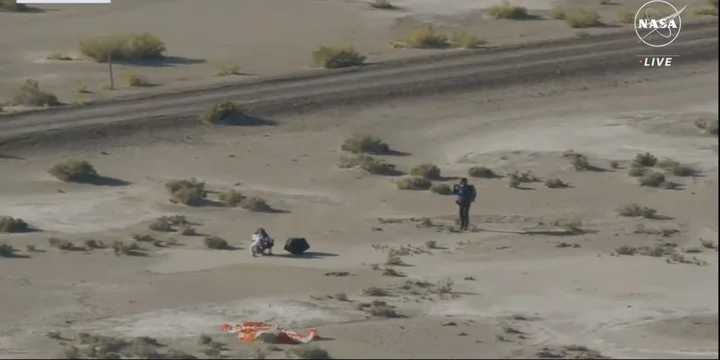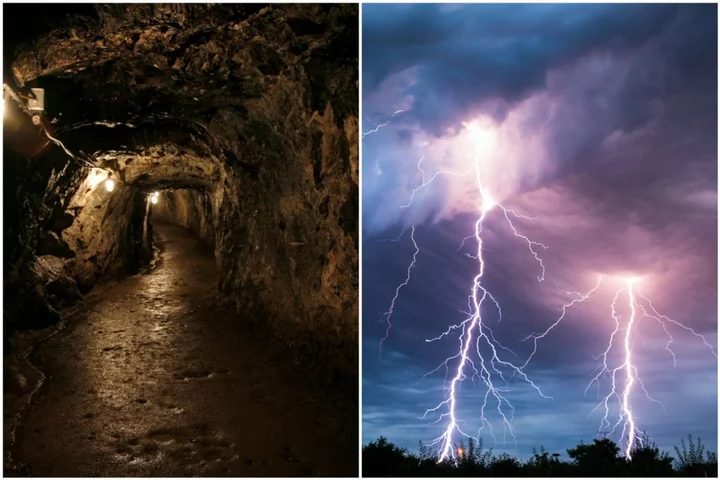A capsule holding precious bits of space rock fell from the sky at breakneck speed Sunday morning, completing the first U.S. mission to bring home a sample from an asteroid.
The capsule's recovery from a Utah desert concludes a seven-year, 4 billion-mile journey through space that may help scientists solve mysteries of the solar system and even shed light on how life sprung on Earth.
NASA plucked the mushroom-shaped pod from the Utah Test and Training Range, southwest of Salt Lake City, after its landing at 8:52 a.m. Mountain Time. The U.S. space agency chose the enormous military base to drop the projectile to avoid risk to human life.
But the charred capsule containing gravel and dirt from the asteroid Bennu didn't stay put for long. A helicopter whisked it away to a clean room at the range's Dugway Proving Ground, the Army's largest and most isolated facility in the continental United States. There it received initial processing.
NASA called the OSIRIS-Rex landing — short for Origins, Spectral Interpretation, Resource Identification, and Security Regolith Explorer — a historic success. Though officials have always expressed confidence that the team would clinch it, the feat has been likened to throwing a touchdown pass over 10 football fields and landing it perfectly in that endzone.
"And touchdown of the OSIRIS-Rex sample return capsule," said commentator James Tralie, during NASA's live broadcast of the landing. "A journey of a billion miles to asteroid Bennu and back has come to an end, marking America's first sample return mission of its kind and opening a time capsule to our ancient solar system."
SEE ALSO: NASA needed help with a mission. The Vatican came to the rescue.About four hours before the landing, flight controllers commanded the spacecraft to drop the capsule while it was still 63,000 miles above Earth. Meanwhile, they were aiming for a target of only 250 square miles on the ground. At its highest speed, the capsule, protected by a heat shield, traveled 27,650 mph, engulfed in a fireball.
Over the past week, rain sprinkled the region, making the desert floor a bit soft and muddy. But the weather improved in time for a capsule scavenger hunt. The mission was met with clear skies and low wind Sunday morning.
The Air Force assisted with the operation, using radar and cameras to determine the precise location of the capsule for the recovery team. With help from its glowing tail, airmen spotted it plunging through the sky at about 8:40 a.m. local time. Within 30 minutes of its touchdown, personnel riding on helicopters rendezvoused with the package, sweeping the area around it for safety. The capsule was found intact, its nose was firmly planted in the ground.
The capsule landed in the Utah Test and Training Range. Credit: NASA / Keegan BarberNow the hard part begins. Scientists say it may take days — perhaps weeks — before they have a grasp on what's in the sample canister. Estimates based on the velocity of the spacecraft suggest it may hold a half-pound or a cup's worth of rubble inside, but no one knows for sure.
Historic significance of OSIRIS-Rex mission
Not since the Apollo moon rocks, collected between 1969 and 1972, has NASA brought back space souvenirs of this magnitude. Japan's space agency, JAXA, on the other hand, has become the global leader in such missions, having retrieved much smaller samples twice already from asteroids Itokawa and Ryugu.
Japan's space agency, JAXA, shared some of its Ryugu sample with NASA. Credit: NASA / Robert MarkowitzNASA's larger $800 million mission, years after the Hayabusa missions, could augur a new era in asteroid research. OSIRIS-Rex's return kicks off "asteroid autumn," said NASA program executive Melissa Morris, a series of crewless space voyages to small worlds in the remaining months of 2023. In October, NASA will launch its Psyche mission to a never-before-seen metal-rich asteroid. Then in November, the Lucy spacecraft will fly by an asteroid in the inner main belt to test its asteroid-tracking navigation system.
The space agency selected Bennu for OSIRIS-Rex because it is chock-full of carbon, meaning it could contain the chemical origins of life. The robotic spacecraft launched in 2016 and arrived at the asteroid two years later. The probe orbited the asteroid for two more years, collecting data, before scooping a sample. Then in 2021, it headed back toward Earth.
Bennu, about 200 million miles away, is as wide as the Empire State Building is tall. The asteroid also has an extremely remote chance of hitting Earth in the 22nd century. Learning about the space rock could be helpful for future efforts to deflect it, should that ever become necessary.
Asteroids are thought to be the leftover rubble from our solar system's formation 4.6 billion years ago. These ancient space rocks — or "grandfather rocks," as one of the OSIRIS-Rex teammates put it — could provide clues about how the entire solar system evolved.
The asteroid Bennu is about as wide as the Empire State Building is tall. Credit: NASAWant more science and tech news delivered straight to your inbox? Sign up for Mashable's Light Speed newsletter today.
What scientists want to learn from Bennu
Scientists are poised to chip away at big questions with the new asteroid sample, like how do organic materials originate, and why did life emerge on Earth?
Scientists say it may take days — perhaps weeks — before they have a grasp on what's in the sample canister. Credit: Andrew Ryan / University of ArizonaThrough the spacecraft's images, the team saw so-called "hydrothermal mineral deposits" on Bennu that they believe may have occurred early in solar system history, said Dante Lauretta, the team's principal scientist, based at the University of Arizona.
These are long veins of salty material that could suggest a hydrothermal system similar to what exists at Earth's mid-ocean ridge. It's a key environment where geologists think origin-of-life chemistry may have begun for this planet. But this material hasn't shown up in Japan's Ryugu sample or any meteorites found on Earth so far.
"What I want to know is how do you go from a simple carbon molecule, like methane, which is a natural gas, to something like amino acids, which make our proteins, or nucleic acid, which makes up our genetic material," Lauretta said.
Bennu earned the nickname "the trickster asteroid" during OSIRIS-Rex's spaceflight. Scientists believed when the spacecraft touched down to collect the sample three years ago, it would encounter pebbles. Instead, closeup images showed boulders and a surface that acted like a plastic ball pit.
Hundreds of scientists and 60 laboratories around the world will study bits of the sample. But the rocks' first stop will be NASA's Johnson Space Center in Houston, where a specially designed clean room and glovebox are awaiting its arrival. The sample is expected to fly on a C-17 aircraft Monday.
About 20 minutes after dropping the capsule, the spacecraft fired its thrusters to avoid Earth. Then it officially began a new mission — OSIRIS-Apex — to yet another asteroid. If all goes well, the spacecraft will reach Apophis in 2029.
As for OSIRIS-Rex, scientists hope to open the lid of the canister on Monday or Tuesday.
"A big part of the job is also getting that material out to the scientific community" to study, Lauretta said. "This is a gift to the world."









